An ileostomy is one type of ostomy, which is an opening that connects the intestine to the abdomen (tummy). Stool passes through this opening intou a pouch outside the body that is emptied and changed regularly.
Children with ostomies are at risk of nutritional deficiencies because of their shortened intestinal tract. They may also have nutritional deficiencies because of the high amounts of energy they spend to recover from illness, during their rapid growth and, in premature infants, from the loss of nutrients that are typically stored in late gestation. Older children and teens may have nutritional deficiencies because of the high amounts of calories they burn as they grow and go through puberty. A chewable multivitamin can help to make up for any vitamins and minerals that may be missing from your child's diet.
Generally, children with a stoma can eat normal foods and formula. However, depending on your child's diagnosis, they may be on special diets or formulas. Your paediatric surgeon and dietitian will follow your child closely and make dietary recommendations as needed.
What is the goal of a special diet for a child with an ileostomy?
The foods your child eats can change the consistency (texture) of their stool. The goal of a special diet is for your child to produce stool that is pasty but not too watery.
If stool is watery, your child may not absorb as many nutrients from their food. Watery stool also increases the risk of leaks and potential soiling from the pouch that is placed over their ileostomy.
There is no specific diet for children with ileostomies. However, some foods may be better tolerated than others.
- Some foods travel through the digestive tract quickly, which can make the stool output loose and more watery.
- Some foods travel through the digestive tract slowly, which can make the stool output more like a thick paste.
Eating foods that both increase and decrease stool output will help control the texture of your child’s stool. It will also make sure that your child is eating a varied, nutrient-rich diet.
Not all people react the same way to foods, so it may take time to learn what works best.
Breastfeeding
The stoma does not interfere with breastfeeding.
Breastfeeding offers many advantages for both the breastfeeding parent and the baby. It is your choice whether to breastfeed your baby.
If your baby is in the Neonatal Intensive Care Unit (NICU), you may need to use a breast pump and save your milk until your infant can be fed. A person who specializes in helping breastfeeding people is called a Lactation Consultant (LC). You may want to ask your NICU nurse if there is an LC available.
For infants on breast milk or formula, the stool may be light yellow and seedy-looking.
Dietary guidelines for proper stool texture
Important: Please tell your child’s health-care team if your child is already on a special diet before you follow any of the guidelines below.
Chew food well
- Encourage your child to chew tough and fibrous foods well to reduce the risk of these foods blocking the stoma (opening).
- If your child does not chew well, consider serving food that is softer or has been cooked for longer.
Eat regularly
- Your child should have three meals and one or two snacks each day.
- Aim to have your child eat every three hours. This will make your child’s bowel work throughout the day and may also help reduce the amount of gas your child experiences.
- New foods can be added to your child's diet one at a time. When a new food is added, it may change the colour or consistency of your child's stool or may result in more gas. This is normal. If the new food causes a problem with stool output, tell your child's health-care provider.
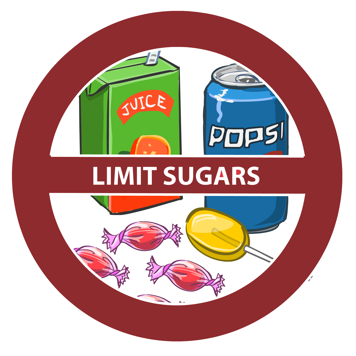
Limit simple sugars and sugar alternatives
Sugars and sugar alternatives can increase gas and bloating. They can also cause very watery stool.
- Avoid sweets and sugary foods such as candies, cookies, soda, juice and syrup.
- Avoid sugar alternatives such as sucrose (Splenda), sorbitol, xylitol and mannitol.
- Read the labels of processed food and choose foods and drinks with less than 10 g of sugar per serving.
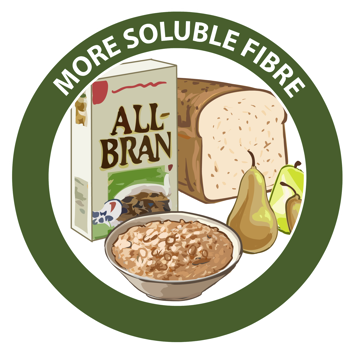
Eat a diet high in soluble fibre and limit insoluble fibre
Soluble fibre dissolves in water and helps to make stool more gel-like. Insoluble fibre (roughage) bulks up stool but can sometimes block the stoma.
- Introduce soluble fibre slowly. Introducing it too quickly may cause gas and bloating.
- To increase soluble fibre, include foods such as oatmeal, pears and most cooked vegetables.
- To reduce insoluble fibre:
- offer breads and cereals made from refined wheat, rye, corn and rice
- remove skins from fruits and vegetables
- use ripe, canned or cooked fruits without skin or seeds
- avoid foods with dried fruit and visible seeds or nuts
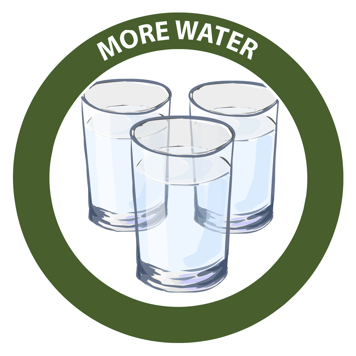
Drink lots of water
If a child has a lot of watery stool, they should drink enough water all day to stay hydrated. Drinking plenty of water can also help soluble fibre make stool output thicker.
- It is especially important for your child to drink water throughout the day during the hot summer months.
- Your child’s health-care team might sometimes recommend low-sugar drinks that contain electrolytes (mineral salts) if your child is losing a lot of water through their stool.
As your child grows, they should consume at least one 8-ounce glass of water for each year of age unless they have to limit fluid intake due to a medical problem.
Children use more body fluids when running, playing and sweating. As your child becomes more active, be sure to provide them with extra fluids.
Once your child is 9 years old, it is recommended that they drink eight to 10 glasses of fluids daily. Have them drink extra fluids while eating food high in fibre, during illness, after exercise and during warm weather.
Recognize the signs of dehydration, such as crying without tears, irritability, dry mouth and lips, less output from their stoma, dry diapers or peeing less, increased sleepiness and sunken eyes. Your child might also feel that their heart is beating faster than normal when they are resting.
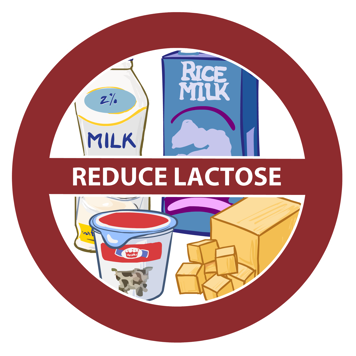
Watch your child’s response to dairy products
Milk and milk products contain a sugar called lactose. Reducing lactose intake can sometimes help to improve your child’s stool output.
- Try lactose-free milk or low-sugar fortified dairy-alternative drinks such as soy or hemp milk.
- Offer your child yogurt and firmer cheese such as parmesan, cheddar or mozzarella. They might find these easier to tolerate than other dairy products.
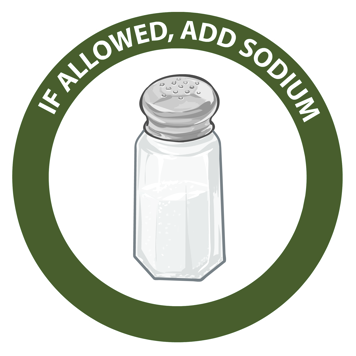
Add sodium to your child’s diet, if instructed
Some children, especially babies, need extra sodium to help them replace the sodium they lose in their stool.
- Only add sodium to your child’s diet if instructed by your child’s health-care team. They will check if your child needs more sodium by monitoring their electrolytes.
- If your child needs extra sodium, the health-care team will suggest which form is best. Options include table salt, salt tablets or a special sodium solution made in a pharmacy.
You can find more guidelines in the table below.
| Food group | Foods to choose | Foods to avoid |
|---|---|---|
| Vegetables and fruit |
|
|
| Grain products |
|
|
| Milk and alternatives |
Everyone tolerates dairy differently – please watch your child’s symptoms. |
|
| Meat alternatives |
|
|
| Other foods | ||
| Fats and snacks |
|
|
| Drinks |
|
|
| Other |
|
|
Record any changes in your child’s symptoms
Not all people react the same way to foods. Some parents find it useful to keep a record of the food their child eats and how this affects their symptoms, for example the frequency and texture of their stool and if they feel less bloated or gassy.
If new foods cause problems with your child's output, consult their health-care provider.
Food blockage
Non-soluble fibres tend to be more difficult to digest and could lead to problems with food blockage. Avoiding these foods, drinking plenty of fluids and chewing food well can help prevent blockage.
Foods that can increase risk of ileostomy blockage are:
- apples with the skin
- bean sprouts
- cabbage (raw)
- celery
- Chinese vegetables
- corn
- cucumbers
- dried fruits
- grapes
- green peppers
- mushrooms
- nuts and seeds
- peas
- popcorn
- relishes and olives
- salad greens
- spinach
- vegetable and fruit skins
- whole grains
Signs of food blockage include:
- cramping near the stoma or the entire abdomen
- abdominal pain
- swollen stoma or belly
- watery or no stool
- nausea or vomiting
- difficulty passing gas
Managing diarrhea
If your child's stool is too loose, there are foods that can thicken it, such as:
- bananas
- rice
- apple sauce
- toast
- starchy foods such as white rice, pasta, white bread and potatoes
If your child has ongoing diarrhea, talk to their health-care provider.
Managing constipation
If your child's stool is too hard, they can experience constipation. To help your child with constipation:
- Make sure your child drinks plenty of fluids.
- Limit low-fibre foods, such as white rice or bread.
- Consider increasing fibre in your child's diet (e.g., bran is high in fibre and is a natural stool softener).
- Encourage your child to get regular physical activity.
If changes in your child's diet do not relieve your child's constipation, talk to your health-care provider as your child may need medication.
When to seek medical attention
If your child has a new stoma and no stool is coming out, go to the nearest Emergency Department to be assessed so your health-care provider can determine if it is a food-related blockage or a small bowel obstruction.
If there is no output from your child's stoma and they do not have nausea or vomiting, they should:
- Stop eating solid food.
- Consume liquids such as warm broth, tea and juice until normal bowel function returns.
- Take a warm bath or shower—this can help relax the abdominal muscles.
- Try a heating pad to help your child's abdomen relax.
- Try walking slowly around your house to help digestion, if it is not too painful.
- Try lying down with knees up to their chest or on the side of their stoma with knees bent to help move the blockage forward.
- Try gentle massage around the stoma to help move the blockage.
Have your child stop eating and drinking and go to the nearest Emergency Department if your child's symptoms persist and:
- you have tried the above and there is no output for several hours
- they have abdominal pain
- they are vomiting
- their abdomen is distended
- their stoma is swollen, or the colour of their stoma has darkened
Take your child's ostomy supplies with you as the hospital may not have the products that you use.

